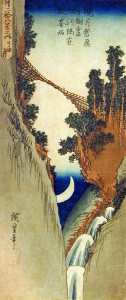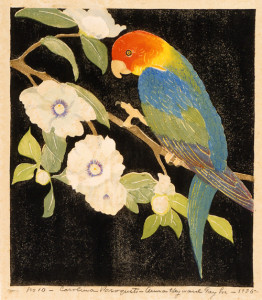If you’ve visited the Gibbes Museum in the past few weeks, you may have noticed some different objects in The Charleston Story exhibition. We’ve changed out a number of works, including a group of woodblock prints by various artists working in this medium. I was particularly interested in this selection of prints because a number of them are actually by 19th-century Japanese artists, and the history behind how this medium influenced many Charleston artists was equally fascinating to me.
Nearly 500 woodblock prints in the Gibbes permanent collection came from one collector, Motte Alston Read. Read traveled extensively and began avidly collecting Japanese woodblock prints in the early 1900s. During this same period, South Carolina artist Anna Heyward Taylor also traveled abroad in Europe and Japan, where she was exposed to the traditional Japanese method of using different blocks for each color to create a polychrome print. Upon returning to the United States, Taylor met American artist B.J.O. Nordfeldt, who had developed a method for using only one block to create a polychrome print. In Nordfeldt’s method, each shape was separated by grooves to prevent the colors from mixing when applied to the block, which produced white outlines around each area of color. Taylor connected with this white-line technique and it can be seen in many of her pieces, including Carolina Paroquet, now on view.


Another South Carolina artist, Alice Ravenel Huger Smith, found inspiration much closer to home here in Charleston. Smith was a close friend and distant relative of Motte Alston Read, and had ample opportunity to study his collection in person. Smith translated many of the techniques she saw in Read’s Japanese print collection into her own work, such as the vertical composition seen in Crescent Moon from the series Twenty-eight Views of the Moon. A similar format is seen in Smith’s Moonlight on the Cooper River, however she incorporates Lowcountry imagery that was familiar to her.
These two artists found inspiration in the vivid colors, respect for nature, and striking compositions that they saw in Japanese woodblock prints. Taylor and Smith made this technique their own by incorporating common themes in Japanese art such as birds, flowers, and landscapes, into their own unique perspective of Charleston and South Carolina.
—Amanda Breen, Museum Relations Summer Intern, Gibbes Museum of Art
Published August 4, 2011


